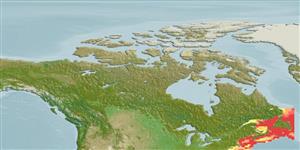Elasmobranchii (sharks and rays) >
Rajiformes (Skates and rays) >
Rajidae (Skates)
Etymology: Malacoraja: Greek, malakos = soft + Latin, raja, -ae = ray, fis (Raja sp.) (Ref. 45335).
More on author: Garman.
Environment: milieu / climate zone / depth range / distribution range
Ecology
Marine; brackish; bathydemersal; oceanodromous (Ref. 51243); depth range 25 - 1436 m (Ref. 106604). Deep-water; 54°N - 40°N, 74°W - 52°W
Western Atlantic: Banks off Newfoundland and southern Gulf of St. Lawrence in Canada to New Jersey, USA. Caught frequently in the river part of St. Lawrence estuary and nearby points in Quebec, Canada (Ref. 4926).
Size / Weight / Age
Maturity: Lm ? range ? - ? cm
Max length : 71.0 cm TL male/unsexed; (Ref. 106604)
Spines are larger toward front and disappear with age on rear parts of tail. Few scapular spines. Group of spines in front of and around each eye. Adults have 1 middorsal row of many small spines, 1 row of small spines on each side, middorsal row of spines extend forward on disk to area behind eyes. Young have 2 pale crossbars on tail, each outlined by a dark blotch or band. Snout pointed (Ref. 7251). Upper surface pale brown with numerous obscure darker spots, irregular pale markings. Lower surface plain white with few small dusky spots (Ref. 6902).
Inhabits soft mud and clay bottoms of the deeper troughs and basins, sands and shells, gravel and pebbles of the offshore fishing banks (Ref. 6902). Benthic (Ref. 5951). Salinity ranges from 32.6 to 35.4 (Ref. 6902). This species is confined to deep water. No occurrence has been found in less than 8 m of water. Oviparous. Distinct pairing with embrace. Young may tend to follow large objects, such as their mother (Ref. 205). Eggs are oblong capsules with stiff pointed horns at the corners deposited in sandy or muddy flats (Ref. 205). Egg capsules are 5.0-5.9 cm long and 3.8-4.5 cm wide (Ref. 41249, 41306, 41301). Caught too sparingly to have any commercial importance (Ref. 27314).
Life cycle and mating behavior
Maturities | Reproduction | Spawnings | Egg(s) | Fecundities | Larvae
Oviparous, paired eggs are laid. Embryos feed solely on yolk (Ref. 50449). Distinct pairing with embrace. Young may tend to follow large objects, such as their mother (Ref. 205).
McEachran, J.D. and K.A. Dunn, 1998. Phylogenetic analysis of skates, a morphologically conservative clade of elasmobranchs (Chondrichthyes: Rajidae). Copeia 1998(2):271-290. (Ref. 27314)
IUCN Red List Status (Ref. 130435)
Threat to humans
Harmless
Human uses
Fisheries: of no interest
Tools
Special reports
Download XML
Internet sources
Estimates based on models
Preferred temperature (Ref.
123201): 0.6 - 7.6, mean 4.1 °C (based on 186 cells).
Phylogenetic diversity index (Ref.
82804): PD
50 = 0.5625 [Uniqueness, from 0.5 = low to 2.0 = high].
Bayesian length-weight: a=0.00240 (0.00149 - 0.00387), b=3.19 (3.06 - 3.32), in cm total length, based on LWR estimates for this species & (Sub)family-body (Ref.
93245).
Trophic level (Ref.
69278): 3.5 ±0.2 se; based on diet studies.
Resilience (Ref.
120179): Low, minimum population doubling time 4.5 - 14 years (Fec assumed to be <100).
Prior r = 0.09, 95% CL = 0.06 - 0.13, Based on 1 full stock assessment.
Fishing Vulnerability (Ref.
59153): High vulnerability (58 of 100).
Nutrients (Ref.
124155): Calcium = 9.5 [1.4, 50.2] mg/100g; Iron = 0.337 [0.071, 1.045] mg/100g; Protein = 16.7 [13.9, 19.3] %; Omega3 = 0.613 [0.180, 2.396] g/100g; Selenium = 11.7 [2.8, 39.2] μg/100g; VitaminA = 9.68 [2.07, 45.52] μg/100g; Zinc = 0.452 [0.222, 0.862] mg/100g (wet weight);
